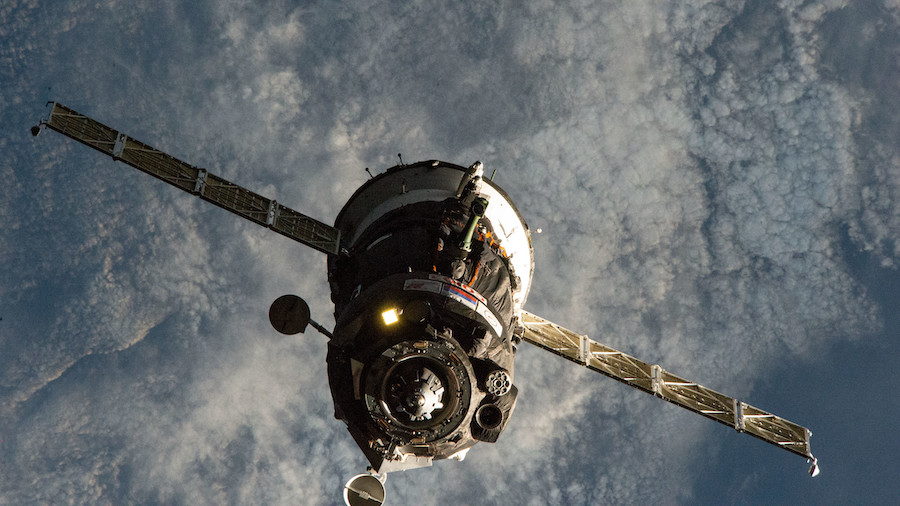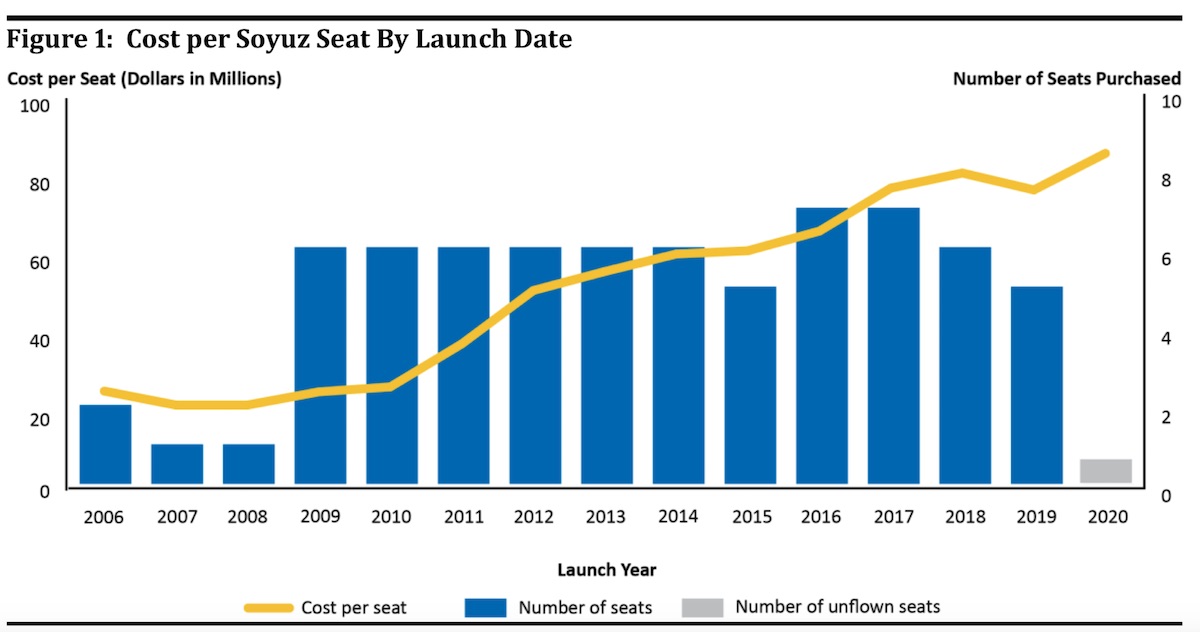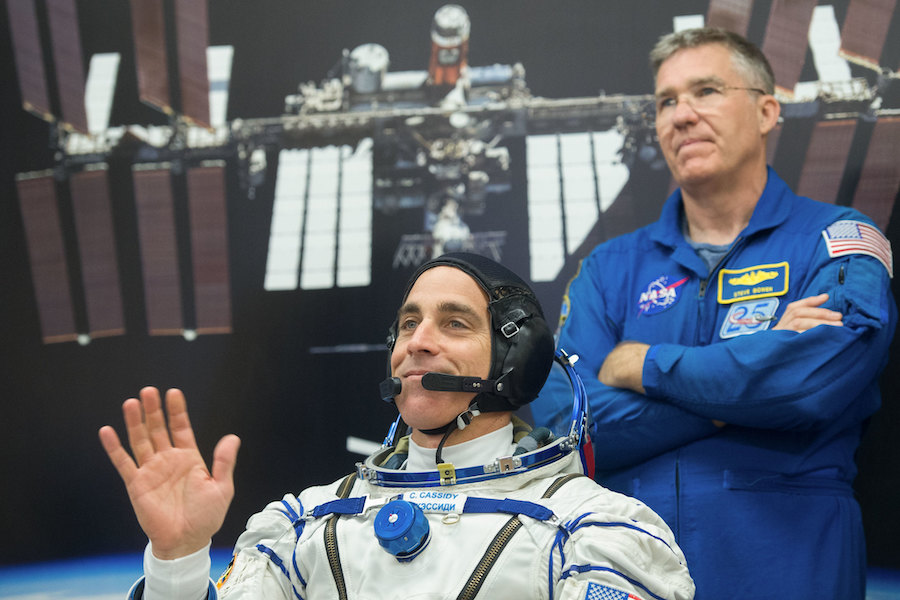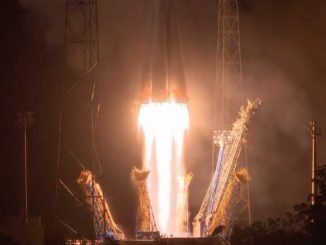
With lingering uncertainty about when new U.S. commercial vehicles can regularly carry crews to the space station, NASA said Tuesday it will pay the Russian space agency more than $90 million for a round-trip ticket to the International Space Station on a Soyuz spacecraft later this year.
According to NASA, the deal with Roscosmos — Russia’s space agency — will ensure continuous U.S. presence on the $100 billion lab complex in case of additional delays in getting new U.S. crew capsules ready for operational missions.
The agreement between NASA and Roscosmos was not a surprise. NASA Administrator Jim Bridenstine said last year such a deal was likely.
Speaking to reporters May, Bridenstine said it was important to make sure NASA astronauts always have a ride to the space station. The first piloted flight of SpaceX’s Crew Dragon spacecraft, named Demo-2 or DM-2, is scheduled for liftoff May 27 from NASA’s Kennedy Space Center in Florida on top of a Falcon 9 rocket.
NASA astronauts Bob Behnken and Doug Hurley will ride the Falcon 9 rocket into orbit, then the Crew Dragon will take aim on the International Space Station for an automated orbital linkup May 28. The two-man crew will return to Earth after one-to-four months, depending on the performance of the capsule’s power-generating solar panels.
But the schedule for the first operational Dragon crew rotation mission hinges on the outcome of the Demo-2 test flight. Three NASA astronauts and one Japanese space flier are assigned to the follow-on Dragon flight, which is scheduled for liftoff some time this fall to begin a mission lasting around six months.
With some lingering uncertainty about when SpaceX’s Dragon capsule will be ready for operational missions, NASA sought another round-trip ticket to the space station on a Russian Soyuz spacecraft, the only way astronauts have been able to reach the orbiting lab complex since the retirement of the space shuttle in 2011.
“To ensure the agency keeps its commitment for safe operations via a continuous U.S. presence aboard the International Space Station until commercial crew capabilities are routinely available, NASA has completed negotiations with the State Space Corporation Roscosmos to purchase one additional Soyuz seat for a launch this fall,” NASA said in a statement Tuesday.
NASA’s other commercial crew partner, Boeing, failed to dock its Starliner spacecraft with the space station on an unpiloted test flight in December. Boeing will repeat the test flight this fall before the Starliner is cleared to fly to the space station with astronauts for the first time.
Under the terms of its agreement with Roscosmos, NASA will pay the Russian government more than $90.2 million for a single seat on a Soyuz spacecraft launching in October from the Baikonur Cosmodrome in Kazakhstan, according to Stephanie Schierholz, a NASA spokesperson.

In response to questions from Spaceflight Now, Schierholz said the $90.2 million figure includes “all necessary training and preparation for launch, flight operations, landing and crew rescue for a long-duration mission as well as some limited crew cargo delivery to and from the station.”
The agreement also covers “ancillary services related to launches and landings,” she said.
The Soyuz spacecraft scheduled for launch in October will remain at the space station for about six months before returning to Earth with its three-person crew next April.
Russia previously intended to fly three Russian cosmonauts on the Soyuz launch in October to help support the installation, checkout and outfitting of a new Russian laboratory module, Schierholz said. Roscosmos will forgo one of their three seats on the Soyuz flight.
As compensation for the lost Russian flight opportunity, NASA has agreed to transport 1,763 pounds (800 kilograms) of Russian cargo to the space station on future U.S. commercial cargo missions over the next two-and-a-half years, Schierholz said.
Kirk Shireman, NASA’s space station program manager, said May 1 the agency is looking for “repeatable” crewed missions on the new SpaceX and Boeing capsules. Each company is contracted for at least six crew rotation missions to the space station, beyond their initial crew test flights.
NASA’s inspector general reported last year the agency is paying an average of around $55 million per round-trip seat on SpaceX’s Crew Dragon spacecraft. Boeing’s price is around $90 million per seat.
NASA has not ruled out paying Russia’s space agency for an additional Soyuz seat on a launch next April.

NASA has not formally announced who will take the Soyuz seat on the October launch. Schierholz said the astronaut assignment will be announced after approval by the Multilateral Crew Operations Panel, which coordinates crew-related issues in the space station program.
Steve Bowen, a veteran of three space shuttle missions, trained as the backup to Chris Cassidy, who took the last Soyuz seat under NASA’s previous contract with Roscosmos. Cassidy launched from Kazakhstan on a Soyuz flight to the space station April 9. He is scheduled to return to Earth with his two Russian crewmates in October, around a week after the next Soyuz crew capsule arrives at the space station.
NASA has paid the Russian government approximately $3.9 billion since 2006 to purchase Soyuz seats for astronauts from the United States and the station’s other international partners, according to a report last year by NASA’s inspector general.
NASA expects to end payments to Russia once the new U.S. crew ships are operational. Under the space agencies’ current plans, U.S. astronauts will continue flying on Soyuz spacecraft and Russian cosmonauts will launch and land on the new U.S. vehicles under a barter arrangement, with no funds exchanged.
But Russian officials say they are not assigning cosmonauts to missions on U.S. vehicles until they are flight-proven.
Flush with NASA money, Russian space contractors doubled the production of Soyuz crew capsules for launches beginning in 2009 to meet the demand for astronaut transportation to the space station. After NASA’s previous purchase of Soyuz seats in 2017 expired this year, Russian officials have cut back the Soyuz flight rate to two flights this year.
“We want the relationship in space exploration to remain strong,” Bridenstine said May 1. “We see a day when Russian cosmonauts can launch on American rockets, and American astronauts can launch on Russian rockets. Remember, half of the International Space Station is Russian, snd if we’re going to make sure that we have continual access to it, and that they have continual access to it, then we’re going to need to be willing to launch on each other’s vehicles.”
Email the author.
Follow Stephen Clark on Twitter: @StephenClark1.



